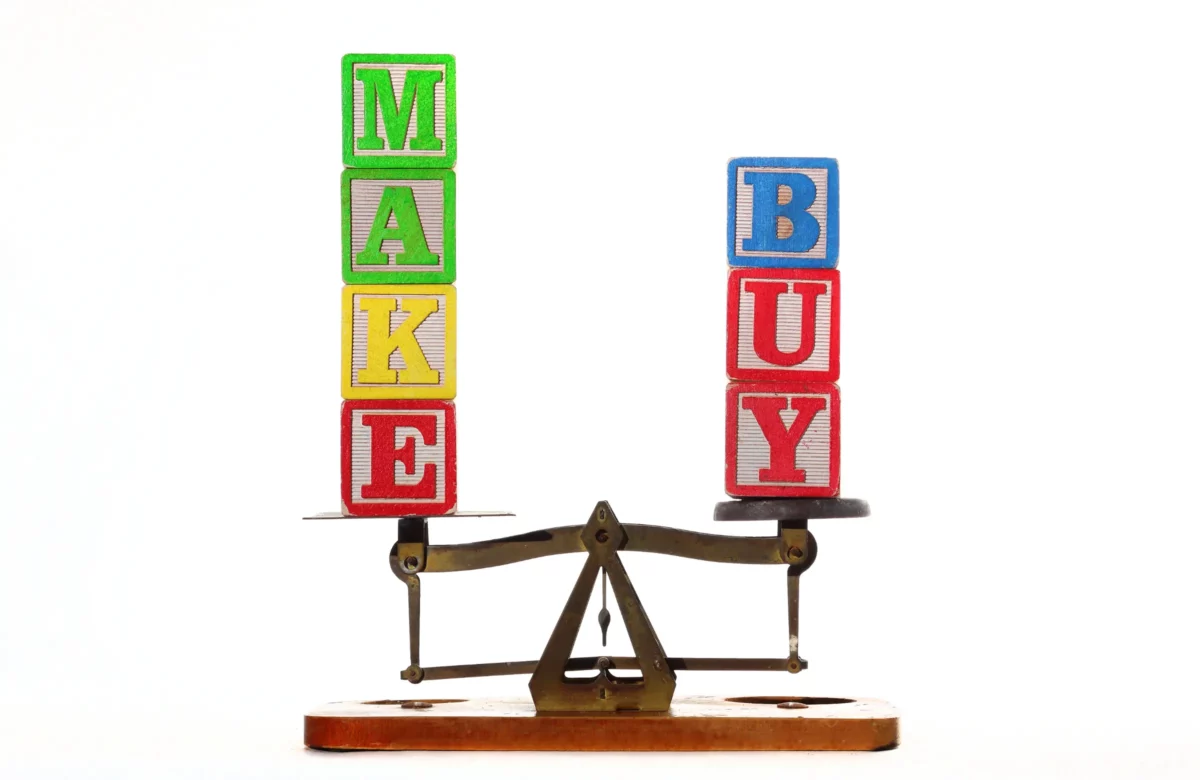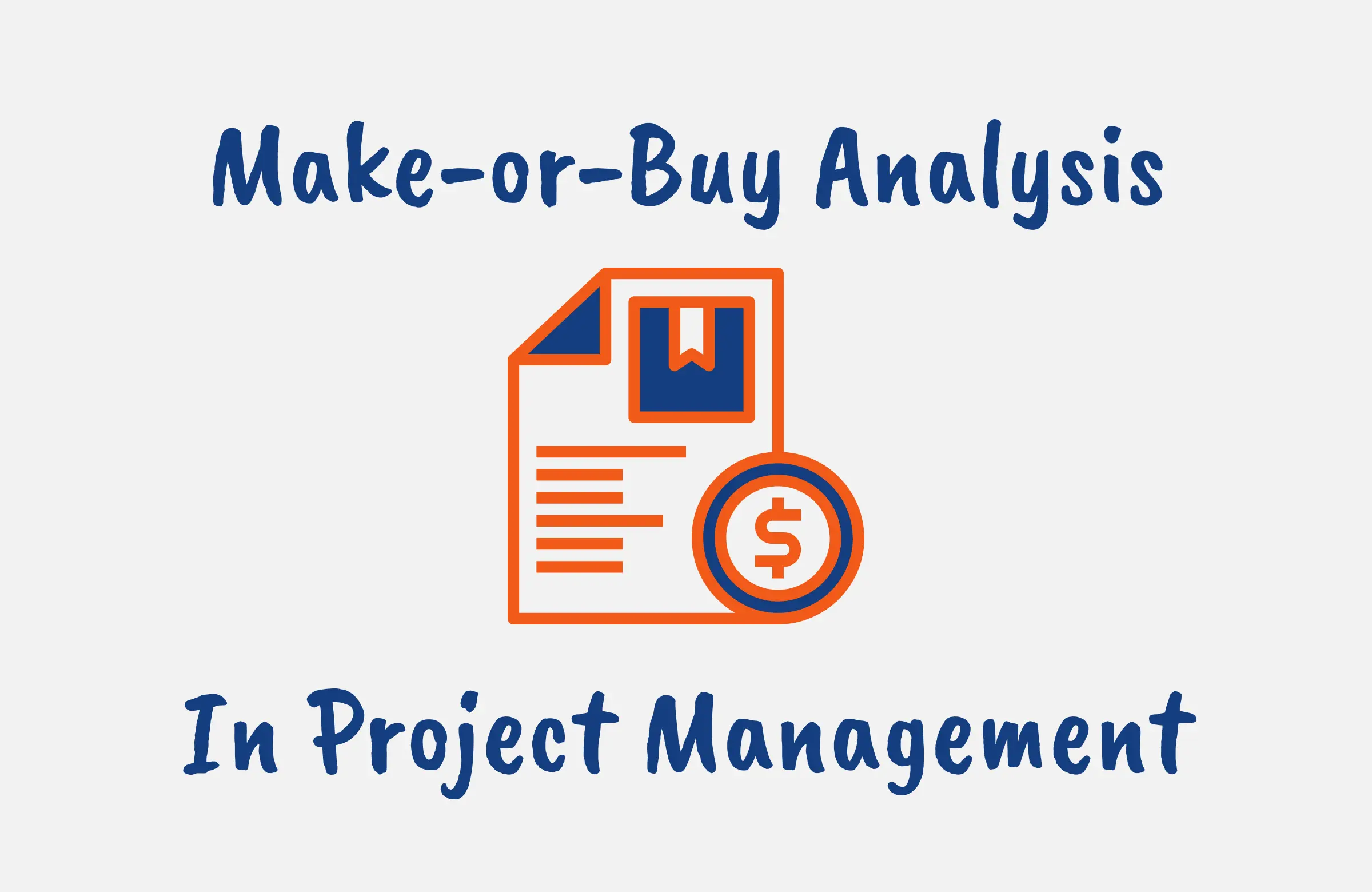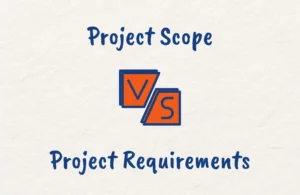When managing projects, you are faced with a ton of decisions. These include critical make or buy decisions during procurement management.
Is it better to produce certain project deliverables internally or outsource them to vendors?
Determining the right answer to this question requires an effective make or buy analysis to evaluate the costs, benefits, risks, and strategic factors.
In this post we look at make or buy analysis in project management, how to use it to make decisions, as well as tips for mastering the concept for the PMP exam.
Make or Buy Analysis Definition
Make or buy analysis is a structured technique used to evaluate whether to produce an item or service internally or outsource it to an external supplier by weighing the costs and benefits of the two alternatives.
The analysis aims to determine if an organization or individual should make the product or service using its facilities, labor, equipment, etc. or buy it from an outside vendor.
The goal is to select the option that optimizes project objectives like cost, schedule, quality, risk mitigation, resource utilization, and alignment to core competencies.
As a project manager, conducting a make or buy analysis is key, especially during procurement activities in the project planning phase.
It informs make or buy decisions on whether to acquire each procurement item or service from the open market or provide it in-house using organizational assets.

Importance of Make or Buy Analysis in Project Management
Make or buy analysis in project management provides key insights that impact:
- Project Scope: It greatly influences the project scope by determining how much work will be handled internally by your team versus externally by vendors. This impacts resource needs and coordination efforts.
- Costs: It provides vital data to compare the total cost differences between making or buying, including both direct and indirect costs like materials, labor, transportation, overhead, and economies of scale.
- Schedule: The decision will likely compress or extend the schedule based on factors like production lead times and shipping logistics. This needs to be incorporated into the schedule.
- Risks: It assesses risks such as supplier reliability, adequacy of specifications communication, and degree of quality control, which can be mitigated upfront.
- Resources: The analysis evaluates if you have sufficient internal skills, capacity, and capabilities to make the item with acceptable quality standards. Resource constraints may dictate buying.
- Core competencies: Core competencies should be considered if certain production abilities are organizational strengths that would be advantageous to leverage.
- Quality: For some items, quality control may be easier to manage internally vs through vendors. This needs weighting in the criteria.
- Strategic Goals: Outsourcing production may enable focusing internal resources on core capabilities that align with strategic goals vs making commoditized items.
Without this vital analysis, you risk sub-optimal procurement decisions that impact timelines, cost, risk, resources, and overall project success.

Make or Buy Analysis Formula
The make or buy analysis formula involves comparing the total costs of making the product or service internally versus buying it from an external supplier.
The key steps are:
- Identify all direct costs such as materials, labor, and allocated overhead for internal production.
- Identify all indirect costs like facilities, equipment, and management oversight.
- Estimate the purchase price from suppliers, including delivery and other fees.
- Account for any opportunity costs from making vs buying.
- Calculate the total cost for each option.
- Compare the total costs and select the lower-cost option.
The formula can be expressed as:
Total Make Cost = Direct Costs + Indirect Costs
Total Buy Cost = Purchase Price + Opportunity Costs

Make or Buy Decision Factors
While make or buy analysis provides vital data, the decision requires weighing several key qualitative factors. Factors you need to consider include:
1. Cost Factors
Will production costs be lower internally versus outsourcing? Consider direct costs like labor and materials as well as overheads.
Then, analyze the total cost of ownership, not just the purchase price. Include ancillary costs like transportation, inventory, inspection, and coordination.
Also, does internal production provide lower overall costs considering all labor, material, equipment, facilities, transportation, and overhead expenses? Keep in mind that outsourcing may have higher per unit costs but no fixed overhead.
Analyze the total cost of ownership over the full lifecycle, not just the upfront purchase price. Then account for ancillary costs like inspection, inventory, coordination, customization, and consumables.
2. Quality Factors
Does internal production allow better quality control than external sourcing? Do vendors possess specialized expertise or equipment to deliver higher quality?
While internal production allows closer control over quality management during the full manufacturing process versus a vendor’s black-box approach, suppliers may have specialized expertise or equipment to deliver higher quality.
3. Capacity Factors
Does sufficient capacity exist internally in terms of labor, facilities, and equipment for internal production? Will outsourcing free up internal resources for core operations vs. ancillary production?
Resource constraints like available labor hours, facilities square footage, and equipment units may dictate outsourcing even if internal costs are lower.
On the other hand, retaining production may allow faster adaptation to changing requirements.
4. Time Factors
Will making the item internally accelerate or delay the schedule compared to outsourcing lead times? How critical is the delivery timeframe?
Internal lead times must be compared to supplier production and delivery timeframes as outsourcing may expedite delivery but reduce flexibility for short-notice changes.
5. Risk Factors
What risks arise from reliance on external vendors like supply delays or quality issues? Does internal production introduce risks from resource constraints, technical issues, or other factors?
Over-reliance on a single or a few vendors creates risks like delivery delays, quality issues, communication gaps, and geographic concentration.
However technical challenges, resource issues, or incompetence risks can arise with internal production.
6. Strategic Factors
Does internal production better leverage organizational core competencies? Does outsourcing enable a greater focus on competitive differentiators?
Internal production better leverages existing capabilities like technical expertise or specialized equipment while outsourcing simplifies resource management to focus on core differentiators.

Make or Buy Decision Advantages and Disadvantages
Whether you decide to produce an item or service in-house or it is outsourced, there are potential pros and cons to either approach.
Advantages of a Make Decision
1. Greater Control Over Production
Making items internally rather than outsourcing gives an organization much greater control over the entire production process, with tight control enabling optimizing operations for maximum efficiency.
This includes closely managing activities like quality assurance, scheduling, resource allocation, capacity scaling, and process improvements.
2. Develops Operational Efficiencies
Internal production allows companies to develop skilled and experienced workforces specialized in their processes, as well as optimize equipment utilization, and streamline workflows to minimize waste.
Also, dedicating workforces and machines to routine production creates efficiencies.
3. Leverages Existing Assets
Producing internally enables leveraging investments already made in facilities, equipment, and worker training. Making use of these existing assets improves their return on investment.
4. Adapts to Changing Requirements
With internal production, organizations can pivot more quickly to modify outputs based on changing requirements. Whereas outsourced production has less flexibility to adapt.
Disadvantages of Make Decision
1. Higher Fixed Costs
Making products requires significant fixed overhead costs including production facilities, heavy equipment, management supervision, and routine maintenance expenses which you’d avoid if you outsource.
2. Limits Economies of Scale
Unless the production volumes are extremely high, in-house production limits the economies of scale that external suppliers can provide through specialization and higher volumes, and the per unit cost is often higher.
3. Ties Up Resources
While outsourcing frees up organizational resources to handle other tasks, dedicated production resources cannot be deployed to other higher-value projects, representing an opportunity cost.
4. Inflexible Capacity
It is difficult to scale internal capacity up and down with changing demand. Excess or insufficient capacity both have costs. Suppliers handle these fluctuating volumes more fluidly.
Advantages of a Buy Decision
1. Specialized Expertise
Vendors are typically focused on a product or process and often develop very specialized expertise that an internal team may not be able to match cost-effectively. Their depth of knowledge can lead to quality and efficiency benefits.
2. No Fixed Overhead Costs
Outsourcing converts fixed costs into variable costs, only paying for the volume produced. It also provides access to economies of scale from the supplier’s larger production across customers.
3. Focus on Core Competencies
Buying from vendors allows the focus of internal resources on an organization’s true core competencies rather than distracting the production of ancillary inputs.
4. Access to Innovation
Suppliers at the cutting edge often have access to the latest technologies, methods, and innovations that an internal team may take time to develop. Buying can provide access to leading-edge advances.
Disadvantages of Buy Decision
1. Less Control Over Suppliers
Buying from external vendors provides less oversight and control compared to internal production. This can lead to issues meeting specifications, quality norms, and delivery timelines.
2. Higher Risk Exposure
Outsourcing creates risks such as lack of supply, geopolitical factors impacting operations, financial instability of vendors, and reliance on a limited supplier base whereas internally managed risks can be lower.
3. Potential Loss of Capabilities
Over-reliance on outsourcing can cause erosion of internal capabilities over time. This loss of competencies can be difficult to rebuild later if needed.
4. Intellectual Property Leakage
Critical organizational knowledge transferred to vendors during procurement processes creates potential IP leakage risks versus keeping production in-house.

Make or Buy Analysis Example
Let’s walk through an example of a make or buy analysis for a software development project.
The project team must decide whether to build the server hardware internally or outsource it to an OEM supplier.
First, the project manager gathers data on internal production costs. These include:
- Direct material costs: $250 per server for components
- Direct labor costs: $100 per server for assembly technicians (at a fully loaded rate)
- Variable manufacturing overhead: $150 per server including utilities, consumables, etc.
- Fixed manufacturing overhead: $5 million per year including equipment maintenance, supervision, and rent
The total estimated manufacturing cost is $500 per server.
Annual production volume is estimated at 10,000 servers, leading to a total internal cost of $5 million + ($500 x 10,000 units) = $10 million.
External supplier quotes range from $600 – $800 per completed server unit including delivery.
Assuming the chosen OEM’s quote is $700 per server, the total outsourcing cost at 10,000 units is therefore $7 million.
Despite higher per-unit costs, in this case, outsourcing provides a lower total cost by leveraging the supplier’s economies of scale and avoiding major fixed overhead expenses.
This example demonstrates using the make or buy formula to quantify the cost trade-offs.
However, the final decision also depends on strategic factors like maintaining internal capabilities and risks associated with supplier dependence, and the best decision balances both financial and qualitative factors.

Challenges of Make or Buy Analysis in Project Management
While a make or buy analysis in project management is a valuable technique, conducting it effectively has several challenges:
- Obtaining accurate cost data on internal production and supplier pricing can be difficult, especially with uncertainty in product volumes, efficiency variances, and indirect costs.
- Forecasting production variables like volumes, quality, scrap rates, and utilization add uncertainty to cost projections.
- Quantifying soft factors like flexibility, risk, quality, and alignment to strategy is largely subjective. Over-reliance on quantifiable financials risks suboptimal decisions.
- Make or buy criteria often conflict, requiring tradeoff judgments between cost, time, risk, control, etc. Disagreements can arise on weightings.
- Analysis paralysis is possible by chasing perfect information, robust models, or consensus. It’s important to strive for appropriate analysis depth within schedule constraints.
- Oversimplification also occurs from glossing over complex interdependencies in procurement economics and logistics.
As a project manager, you need to apply your leadership capability to drive an efficient yet sufficiently thorough make or buy analysis process.
Leverage your team’s expertise while mitigating potential biases and keep challenging assumptions to avoid suboptimal make or buy decisions.

Make or Buy Analysis PMP Exam Tips
Procurement management and planning is a part of the PMP exam content outline, and this knowledge area requires knowledge of make or buy analysis.
While it is highly unlike that you will be required to do any calculations on make or buy analysis or decisions in your PMP exam, it’s important to master the concept.
When procurement management questions arise, remember these tips:
- Know the make or buy analysis inputs, evaluation criteria, and outputs. Be able to walk through the decision process.
- Recognize how it fits into the Plan Procurements process and impacts the project management plan.
- Study the make or buy formula to analyze direct and indirect costs. But also consider strategic qualitative factors.
- Understand challenges like obtaining accurate data and quantifying soft factors. Analysis paralysis and oversimplification are common pitfalls.
- Sunk costs are not a factor to consider when doing make or buy analysis.
- Review examples of make or buy scenarios and decisions focused on cost-benefit tradeoffs.
Conclusion
Make or buy decisions are a critical part of project management that compares internal production to external sourcing.
By conducting a structured make or buy analysis using the simple cost formula and evaluating strategic factors, you gain key insights to optimize procurement choices.
Frequently Asked Questions
Once the Make-or-Buy Analysis is Completed Which Document defines the Project Delivery Method?
Once the make-or-buy analysis is complete, the Project Procurement Management Plan defines the project delivery method.
It outlines how procurement will be managed, including contract types, vendor selection, and management of contracts and vendors.
Which Activities Are Typically Carried Out in a Make-or-Buy Analysis?
In a make-or-buy analysis, activities typically include evaluating the costs, risks, and capabilities associated with making a product or service internally versus purchasing it externally.
It also involves considering factors like time constraints, quality control, and the strategic fit of the decision.
What are the 2 Major Factors in a Make-or-Buy Analysis?
The two major factors in a make-or-buy analysis are cost and capability.
Cost involves comparing the expenses of producing in-house versus outsourcing, while capability assesses if the organization has the resources, skills, and capacity to produce the product or service internally.
What is a Make-or-Buy Strategy?
A make-or-buy strategy is a business decision-making approach where an organization evaluates whether it’s more cost-effective and feasible to produce a product or service internally (make) or to purchase it from an external source (buy).
It considers factors like cost, capacity, competency, and risk.
What are the Three Pillars of Make vs Buy?
The three pillars of the make vs buy decision are business strategy, risks, and economic factors.
Business strategy evaluates alignment with organizational goals, risks assess potential uncertainties and their impact, and economic factors analyze the financial implications of the decision.
What is the Gray Zone in Make-or-Buy?
The “gray zone” in make-or-buy decisions refers to situations where the choice between internal production and external procurement isn’t clear-cut.
Factors like strategic importance, capacity, quality control, and proprietary knowledge can create ambiguity, necessitating a more nuanced analysis and decision.





